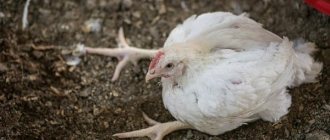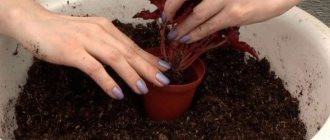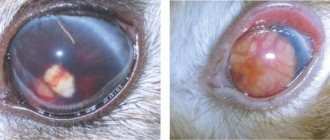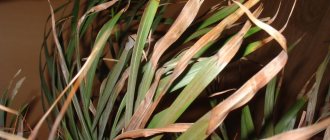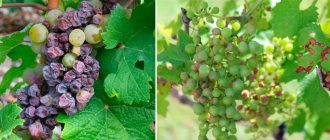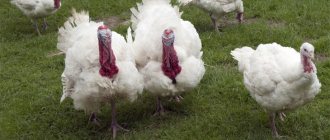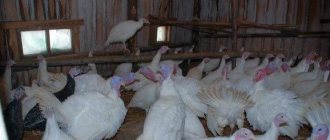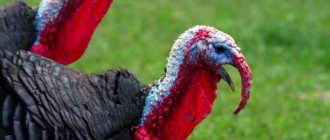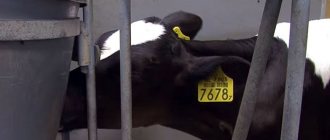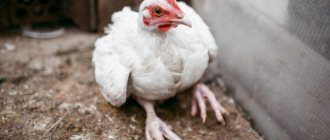Causes of sinusitis
Inflammation of the mucous membrane of the nasal sinuses can occur not only when the bird is hypothermic.
Sinusitis occurs when livestock are kept in unsanitary conditions. If there is no ventilation in the poultry house, the air stagnates. It accumulates a lot of ammonia vapor, carbon dioxide, and hydrogen sulfide. These substances irritate the mucous membranes of the upper respiratory tract. It becomes inflamed and swollen. Pathological microflora accumulates in it, which leads to the appearance of purulent exudate
In a room for turkeys, it is important to provide a ventilation system:
- dampness and humidity, dirty bedding - all this negatively affects the health of birds. Being in poor conditions, the livestock may develop infectious diseases. Sinusitis in this case is a symptom of some pathological manifestation. The disease is diagnosed with tracheitis, laryngitis, conjunctivitis, mycoplasmosis;
- the mucous membrane becomes inflamed if helminths are parasitic in the body. Turkeys suffer from a runny nose and cough when they ingest roundworms, pinworms, and trichinella;
- One of the causes of sinusitis is vitamin A deficiency. A lack of retinol reduces the immunity of turkeys and reduces the resistance of the mucous membranes to pathological microflora. Against the background of vitamin deficiency, respiratory and infectious diseases develop;
- Male turkeys, being in the same herd, often fight. They seriously injure each other. When the nasal sinuses are injured, the integrity of the mucous membrane is compromised. Sinusitis develops. The disease resolves with the release of blood and pus. Necrosis of nasopharyngeal tissue is noted.
More on the topic: Why do turkeys pluck each other's feathers?
Turkey poults are most often exposed to negative environmental influences. Their immunity is weak. They need warmth, fresh air and clean, dry bedding. Among young livestock, sinusitis is a common disease. Case is high. Chicks die from asphyxia and exhaustion
It is very important to identify sinusitis at an early stage. This will help preserve the livestock
Why do turkeys have swollen faces?
The appearance of tumors on the face of turkeys indicates inflammation of the nasal sinuses. The condition develops when infected with the bacteria mycoplasma gallisepticum, which causes the disease sinusitis.
Additional signs of infection include:
- mucous discharge from the nose;
- depression;
- discharge from the eyes;
- hoarse breathing;
- cough.
The pathology is contagious: the pathogen is transmitted through contact with a carrier, through the air, through equipment, through the hands of the owner, weakening the livestock. In 25% of cases it causes the death of young animals.
Attention! When signs of infectious sinusitis appear, it is important to diagnose the disease promptly to prevent its spread. Eggs from sick parents are destroyed, turkeys are treated with antibiotics, and then slaughtered, since mycoplasmosis cannot be completely cured. The farm is being disinfected.
Symptoms of diseases leading to falling on your feet
Before finding out how to treat sick livestock, you need to identify the disease. The easiest way is to contact a specialist who, after examination, will make a diagnosis. But this is not always possible. Therefore, you need to navigate at least the main diseases. We will look at what signs appear in the most common diseases and tell you what causes these diseases.
Arthritis
This disease occurs quite often. It is characterized by curvature of the limbs and enlargement of the joints. Also, over time, birds lose their appetite and become lethargic. But, in fact, the only sign of the disease is that the limbs are bent. The rest appear in the absence of treatment and are caused by pain experienced by the bird. If left untreated, turkey poults stop walking and eventually die. This disease is not contagious. Accordingly, the entire livestock will not get sick.
Arthritis is caused by excessive consumption of protein foods. Accordingly, prevention comes down solely to proper nutrition of birds.
Newcastle disease
The disease begins due to poor care
This is an infectious disease. Accordingly, it is transmitted from one individual to another. In this case, the disease is transmitted very quickly. Therefore, symptoms begin to appear in almost all young animals at the same time. In addition to leg weakness, which is the main symptom of the disease, chicks experience diarrhea. Feces with this disease have an extremely unpleasant odor. In addition to problems with the gastrointestinal tract, loss of appetite and lethargy are observed. In turkey poults, the crop increases in size, the wings become motionless.
The cause of this disease is non-compliance with sanitary and hygienic standards. Prevention of Newcastle disease is disinsection in the poultry house, which must be done at least once every 2 years. Also remember to keep feeders and drinkers clean. Unfortunately, today there is no medicine for this disease.
This disease is infectious in nature. Accordingly, like Newcastle disease, it is dangerous for all livestock in the poultry house. A symptom of typhus is an unsteady gait. turkey poults stagger from side to side when walking, moving at a slow pace. Symptoms of typhus include loss of appetite and lethargy.
The disease is dangerous and in most cases leads to death. The surviving birds are carriers of the infection. The meat and eggs of these birds cannot be eaten. To prevent typhoid, vaccination is necessary.
Rheumatism
Like arthritis, rheumatism occurs due to negligence on the part of a person. Cold and dampness are the cause of the development of rheumatism. At the initial stage of the disease, birds experience pain while walking. Accordingly, his gait becomes unnatural; he often sits down on the floor. If left untreated, rheumatism is fatal.
Prevention of rheumatism is to maintain a normal temperature in the room (not lower than 150C for adults and 250C for young animals).
Respiratory mycoplasmosis
This disease is caused by microorganisms. If a turkey does not have problems with immunity, then it can resist these microorganisms without any problems. With weak immunity, the bird begins to get sick. Respiratory mycoplasmosis is transmitted by airborne droplets. As a rule, young animals suffer from it.
First of all, the eyes begin to turn red and discharge from the nose appears. Then a cough appears, the plumage begins to look untidy, the legs swell, the appetite disappears, after which, if left untreated, the legs give out and the eyes close.
Prevention of the disease is vaccination of young animals. Also, do not forget to give your birds vitamin complexes to maintain immunity.
Synovitis
Another non-infectious disease that is not transmitted from one bird to another. During synovitis, turkey poults' joints become inflamed. Symptoms of synovitis include lethargy and pale skin folds in the neck area. During illness, the legs swell in the joint area. At the initial stage of the disease, the chicks limp, after which they completely fall on their feet. At an advanced stage of the disease, diarrhea may appear.
Prevention of synovitis is good nutrition and normal living conditions.
If possible, seek medical advice. Sometimes it is very difficult to distinguish one disease from another.
Why do turkeys have crooked legs?
Curvature of the legs in turkeys occurs when there is inflammation in the joints due to infection, the development of arthritis or rheumatism.
Synovitis
Synovitis is caused by inflammatory processes in the joints.
The cause of curvature of the legs in young turkeys aged 4-24 weeks is inflammation of the synovial membrane of the joint and tendons.
Synovitis develops as a result of the bird’s body’s reaction to the penetration of mycoplasma infection. Young animals become infected from laying hens at the embryonic stage or from sick birds. Exacerbation occurs when conditions of detention worsen.
The disease manifests itself with the following symptoms:
- joints become swollen;
- legs become crooked;
- the chick limps, sways, sometimes falls;
- the individual is stunted.
Infection with synovitis leads to exhaustion and dehydration, anemia, and worsens the course of other pathologies. Treatment is carried out with antibacterial agents: a group of tetracyclines, macrolides and fluoroquinolones.
But the infection cannot be completely eliminated, so the bird is subsequently slaughtered for meat.
Advice! To prevent the development of the disease, healthy turkey poults are vaccinated, disinfection measures are carried out, and eggs are treated with disinfecting solutions before being placed in the incubator.
Arthritis
The inflammatory process in the joints of turkeys occurs due to the increased protein content in the feed, lack of movement, and infection. The skin in the area of the affected joint turns red, becomes hot to the touch, and sometimes there is a thickening of the area due to swelling of the joint capsule.
The bird limps when walking and spends most of its time sitting due to severe pain. In advanced cases, deformation of the joints occurs, as a result of which the limb loses mobility.
Treatment is with ampicillin. The medicine is added to the food throughout the week. If necessary, therapy is continued after a week's break.
Rheumatism
The inflammatory process in the connective tissue and joints of the legs of turkeys occurs when kept in a damp and cool room for a long time.
The development of the disease is associated with a lack of microelements and vitamin E. The pain makes the bird’s gait unnatural; it prefers to sit, ignoring feeding. If left untreated, the disease leads to the death of the individual.
To eliminate the disease, young animals are placed in a dry, warm room, chalk and vitamin complexes are added to the feed. Treatment is carried out with sulfonamides. Since there is a high probability of relapse, the bird is slaughtered after the symptoms are eliminated.
Causes of cannibalism
Why do early turkey poults peck each other until they bleed? The person responsible for the fastidiousness of turkeys is the man who bred early maturing breeds that require extremely high concentrations of feed vitamins, essential carboamic acids, as well as special housing conditions. Among the main causes of pterophagy in turkey poults are the following:
- Feed factors.
- Inappropriate conditions of detention.
Feed factors
Deficiency of energy, essential amino acids, biological catalysts. It is impossible to independently prepare a feed mixture that satisfies all the needs of the chicks.
An imbalance of nutrients leads to the appearance of defects on the skin. Thus, with a deficiency or excess of protein, retinol is destroyed, acidosis develops, digestion is disrupted, and the cloaca becomes contaminated. The feathers around it stick together, the skin becomes inflamed and cracks. The affected area itches, the chick pecks it until it bleeds. Healthy turkey poults experience hunger, which they strive to replenish through alternative sources - the bodies of those around them.
Turkeys don’t like newcomers
Inappropriate conditions of detention
Windowless rooms with a controlled microclimate minimize the problems of pterophagy, which is not observed when keeping turkey chicks in a personal yard. Among these problems, the most important are the following:
Light mode. The duration of daylight and illumination matters. Too bright light irritates laying hens and stimulates egg laying. The cloaca is constantly hyperemic. If birds of all ages are kept together, hungry chicks pounce on the source of essential amino acids.
- Low air humidity. The feathers of turkey poults become brittle when they dry out. Chicks squeeze out lubricant from the coccygeal gland, damaging the skin. Blood spots appear, which the hungry bird pounces on.
- Crowding. There is not enough space, the feeding front is too narrow, the floor becomes dirty from excrement, the chicks become irritated and have conflicts. With such maintenance, there is a high probability of ectoparasite infestation, in which the skin itches, feathers fall out, droplets of blood appear, and the chick is pecked. Cannibalism is facilitated by the juvenile change of down, which occurs at 5–6 weeks.
- Keeping birds of different ages together. The big ones peck at the little ones, the chicks peck at the laying hens.
- Adding new individuals to the herd. Turkey poults peck at strangers.
Why doesn't the turkey get up on its feet?
A bird’s refusal to stand on its own is an alarming sign of the development of diseases of the musculoskeletal system. Refusal to stand up is usually not accompanied by any other symptoms. The bird appears to be quite healthy.
However, this is a misleading impression. At the first symptoms, the farmer should respond as quickly as possible. After all, even immobilization for a short period of time can lead to the death of an individual.
The disease can be caused by both a viral disease and improperly organized conditions for keeping turkeys. The main reasons why a turkey cannot stand on its own are given below.
- Lack of vitamins, in particular calcium. Calcium is necessary for the normal development of both the bird embryo and the chick that has already been born. That is why farmers are advised to feed him boiled eggs, cottage cheese, and dairy products in the first weeks of a turkey’s life. You can also give bait, bone meal, which contains calcium. You can purchase generic calcium tablets at your veterinary pharmacy. In order to prevent diseases of the limbs, it is necessary to give the chicks dairy products and eggshells daily.
- If the turkey cannot sit on its feet, the body may not be receiving enough vitamins A and E. They are necessary for the development of the muscular and musculoskeletal system. In addition to the vitamins listed above, birds should be given vegetable fats and mineral complexes to generally strengthen the immune system and prevent diseases of the musculoskeletal system.
- A cramped turkey housing area is another reason why turkeys may perch on their feet. Quite large in size, these exotic birds require plenty of space to live and roam. The poultry house should be built or a room selected for it taking into account the recommended standards for occupancy. There must be at least a square meter of space per adult bird. For walking, the enclosure should be more spacious. An adult should have about two square meters when walking. If you do not follow the rules for keeping birds, the risk of injury increases due to crowding in the poultry house. Weak birds will not be able to develop normally, which will lead to the progression of the disease.
- Lack of early vaccination can also trigger the development of diseases such as Newcastle disease or smallpox. Newcastle disease is a real scourge for farmers; this disease cannot be treated. If a bird is sick, it quickly becomes paralyzed. Turkeys' legs become twisted and they cannot stand on their feet or move independently. Also a distinctive feature of infection with the virus is a swollen goiter and foul-smelling diarrhea. Birds infected with the Newcastle virus instantly infect the entire flock and die in a short time. Treatment methods for the disease have not yet been found; the only way out is to fully vaccinate birds in a timely manner.
- Dampness and cold in the poultry house can trigger the appearance and rapid development of diseases such as arthritis. This disease negatively affects the healthy development of the limbs. The feet of birds with arthritis may turn outward; turkey poults cannot stand on their feet and cannot move independently. Arthritis in advanced forms prevents birds from moving independently around the poultry house. Sometimes sick individuals cannot even reach the drinking bowl and feeders.
- An unheated room and cold can also provoke a disease such as rheumatism. Due to rheumatism, birds cannot stand for long periods of time; turkeys cannot stand on their own. This happens because the disease provokes weakening of ligaments and muscle fibers. To improve the condition of the birds, you should insulate the walls of the poultry house and, if necessary, provide heating to the room. You also need to reconsider the diet of turkeys; you need to include a large amount of greens at every meal. Birds should also be given vitamin and mineral complexes.
YouTube responded with an error: The request cannot be completed because you have exceeded your quota.
What to do if turkey poults don’t get up
If therapy and elimination of unfavorable factors have not brought visible results, and the turkey poults still do not get back on their feet, then perhaps the reason lies much deeper. First of all, the owner must carefully check the living conditions of the turkeys, and also invite a veterinarian who will help deal with the deviations of the birds.
Sometimes turkey poults falling on their feet are not associated with mechanical injuries, nutrition or disease. Some birds have weak ligaments from birth, so the birds' limbs move in different directions. To exclude such phenomena in the future, it is necessary to carefully select birds for breeding and provide parents with everything necessary for the birth of healthy offspring.
In addition to weak ligaments, young turkeys falling on their legs can be caused by improper nutrition. By saving on factory-made feed containing the necessary elements and minerals, farmers independently create a menu for the chicks. The composition of homemade mixtures is not always balanced in terms of the content of useful substances, which can lead to paralysis of the limbs.
Causes
The first and perhaps most common reason why turkeys fall on their feet is a high density of birds in a confined space. For normal development of the lower extremities, turkey poults need space. In addition, crowding contributes to the development of various diseases, as a result of which birds may begin to fall on their feet. Experienced poultry farmers know that turkey poults, especially at an early age, are extremely susceptible to various diseases.
Wounds on the bird's legs caused by pecking, fighting, or improper bedding can also cause turkeys to fall.
Arthritis in turkeys occurs as a result of an excess of protein in the feed, which also leads to weakening of the legs of turkey poults.
The most dangerous reason why poultry house inhabitants fall on their feet is, among others, the presence of infectious diseases in the bird. This symptom (falling) most often occurs with Newcastle disease. As a result of this practically untreatable disease, birds become paralyzed.
If you put the chick on its legs, they move apart and do not hold the body at all. The reasons for this phenomenon may be different. Here are the main ones:
- Crowding of turkey poults in a small room. It is a very active bird in the wild. She gets food while constantly on the move. Staying in a cramped room, her movements are limited, and the incorrect formation of tubular bones begins;
- Violation of sanitary and hygienic maintenance standards;
- Excess of vitamin A, soy or corn in the feed;
- Diseases;
- Mechanical damage.
Synovitis (inflammation of the joints).
You can first find out about the causes of leg weakness by the following signs:
If the chick's limbs are moving apart, but it has a good appetite, then this is most likely due to poor nutrition or a small habitat. But when diarrhea appears and the chick is inactive, then most likely, falling on its feet may be one of the symptoms of some disease.
Conditions of detention
Care from the first days is not an easy matter; you should not think that raising a large turkey is easy. It is necessary not only to correctly formulate a feeding diet, but also to know the secrets of keeping this bird. This is especially true for turkey poults, because they require certain conditions:
- It is better to use the type of breeding: outdoor with walking;
- When fattening, place no more than four four-month-old turkey poults per square meter of area;
- The norms for bedding requirements for turkey poults up to 4 months are: layer thickness – 15 cm, requirement per head for the entire period of keeping – 6 kg. They use peat, shavings, straw, etc.;
- Fence off an area in front of the brooder, the so-called solarium, for walking. It is better to put a net on top to protect the turkey poults from wild birds;
- Slat or mesh floors are best installed at a height of 15–30 cm from the litter.
- The length of feeders and drinkers per head for 1-2-week-old young animals is from 3 to 6 cm (depending on the feed). For 2–8 week olds – from 5 to 15 cm. Turkey poults should feel free and not push around when eating. This eliminates traumatic situations;
- Preparation of a balanced diet. If the chicks do not receive the necessary microelements, this can also lead to their legs moving apart. Therefore, the diet should include chalk, fish or meat - bone meal, greens, vitamin supplements with calcium to strengthen bone tissue.
The cause of falling on their feet may be feeding turkey poults corn, soybeans in unlimited quantities, as well as feed with a high protein content.
The legs of small turkey poults can also move apart due to some diseases characteristic of birds.
Diseases
Reasons for leg failure in chicks can be:
- Common injuries. When constructing the floor of the poultry house, there may be sharp corners and unbent nails. Turkey poults injure their paws, and as a result, infection can occur. Therefore, before launching young animals into an adapted room, it is necessary to very carefully check the floor to prevent traumatic situations;
- Poor health. The legs of day-old turkey poults may move apart due to poor health, since non-breeding stock was used for breeding;
- Vitamin deficiency D. Lack of calcium, phosphorus, vitamin D in the diet or their incorrect ratio. The bones become soft. They become bent very easily and the joints become thick. The chicks fall to their feet;
- Diseases. Some diseases lead to the fact that the legs of turkey poults begin to fail. This happens in the first days or weeks of life. The cause of this phenomenon may be diseases: rheumatism, arthritis, Newcastle disease, synovitis, infectious bursitis and others.
Reasons for turkey poults falling on their feet
Conventionally, all the reasons leading to turkey poults falling on their feet can be divided into 2 groups:
- inadequate care conditions;
- diseases.
Let's consider each group of reasons separately.
Inadequate care conditions
There are certain requirements for keeping turkey poults. We won't talk about them now. But, failure to comply with these requirements will certainly lead to health problems. The turkey poult weighs quite a lot. In order for the limbs to develop correctly, he needs to walk, even if we are talking about broiler breeds that are fattened for meat. Accordingly, there should be enough space in the poultry house. It is also necessary to equip a spacious enclosure. Turkeys are not suitable for cage keeping.
Turkey poults may also fall on their feet if they do not receive all the necessary nutrients. Be sure to add mineral additives to the mash (chalk, fish and meat and bone meal, chopped herbs, etc.). Don’t forget that from time to time you need to give your birds vitamins. A lack of calcium has a particularly negative effect on bone development. Make sure that birds receive this microelement in the required quantities.
Another reason why turkey poults fall on their feet is not known to all poultry farmers. Excessive amounts of fat can kill birds. Therefore, you should not overuse corn and natural soybeans. Also beware of foods high in vitamin A and high protein feeds. The diet must be balanced and well thought out.
Diseases
Many diseases cause birds to fall on their feet. Turkey poults are especially susceptible to diseases in the first months of life. Therefore, keep a close eye on them during this period. Leads to Newcastle disease, typhus, synovitis, arthritis and rheumatism. Sometimes illnesses lead to turkey poults' legs turning out.
It is very important to get treatment in a timely manner. If we are talking about an infectious disease, then it will spread quickly and lead to mass death of livestock.
Sometimes the reason for falling on your feet is the most common injuries received during a fight. Birds can also receive such injuries if the poultry house is poorly equipped. When making all wooden elements, the boards must be sanded well. All floorboards, despite the fact that they are covered with a layer of straw, must be smooth and even.
Sometimes birds' limbs become loose, which leads to them falling. the reason for this is poor health, and in particular weak ligaments, from birth. If turkeys used for breeding lack nutrients, then you should not expect strong and healthy offspring.
How to help a bird?
Laboratory tests will establish a diagnosis and subtitrate the microflora to the most sensitive antibiotics, but this will happen over a period of 5-8 days. What to do in this situation, how to not allow the process to develop further? You can’t hesitate and you need to take drastic measures.
When choosing what to treat, you need to give preference to highly effective drugs. To suppress the action of pathogenic microflora, complex agents of the latest generation from the group of fluoroquinolones are used:
Tricolin. The medicine contains two antibiotics: enrofloxacin and collistin. By insuring each other, they enhance the effect and quickly promote the growth and reproduction of the pathogen.
To prepare a medicinal solution, 1 ml of the product is dissolved in a liter of clean water. In the morning, the drinking bowls are washed, medicine is poured in, and the turkey poults drink it throughout the day instead of water. Drinking is carried out for 5-6 days in a row.
Enrofloxacin. This antibiotic is diluted using the same principle.
Diluted preparations can be stored for 24 hours at a temperature of 5 to 15 ᵒC.
For treatment, you can also use analogues: “Kolitil”, “Danoxan-50”, “Flocin”, “Tilmicon”. Dilution is carried out according to the instructions.
Often, a novice poultry farmer cannot understand why turkeys fall on their feet. How to treat sick animals? Before answering this question, a correct diagnosis must be made.
Why turkeys fall on their feet: main reasons
There are various dangerous reasons that provoke massive falls of turkeys on their feet and contribute to the appearance of diseases of the musculoskeletal system. The development of this condition is facilitated by unfavorable exo- and endogenous factors of various types.
Important! Twisting and weakness of the legs in turkey poults and adults can be caused by contagious and non-contagious diseases and other reasons. The main causes of weakness and curvature of the legs of turkey poults:
The main causes of weakness and curvature of the legs of turkey poults:
- hypo-, avitaminosis (rickets);
- unbalanced, low-nutrient diet, feeding turkey poults with low-quality feed and fodder;
- large crowding in poultry houses;
- metabolic disorders in the body;
- inattentive, careless attitude towards the bird;
- neglect of sanitary and hygienic standards in premises where poultry are kept;
- severe injuries, damage to limbs;
- viral, bacterial, invasive diseases;
- congenital pathologists of the musculoskeletal system;
- joint diseases (arthritis);
- unfavorable conditions (low temperature, high humidity);
- frequent stress.
One of the main reasons for weak limbs in turkeys is that the birds are kept too densely. If turkey chicks do not have the ability to move normally, in conditions of limited space, very often the chicks’ limbs become weak or twisted. In addition, large crowding of birds can cause the development of various infections, most of which pose a real threat to the life and health of small turkey chicks.
If turkey poults do not get up, constantly fall on their legs, the turkey often sits on its limbs, perhaps the bird’s body with feed does not receive sufficient quantities of nutrients necessary for normal growth and development (phosphorus, potassium, calcium, sodium, magnesium, selenium). Young animals grow and develop quickly, so the diet must fully meet the energy expenditure of the body. The turkey chick must receive the necessary macro- and microelements, amino acids, and vitamins with feed.
A deficiency of nutrients disrupts redox processes in the body and metabolism. A lack of calcium, manganese, and phosphorus can provoke perosis, a disease that affects bones, bends the spine, and deteriorates plumage.
Trauma to the limbs due to improperly arranged bedding, wounds on the legs due to pecking, arthritis that develops in chicks due to an excess of protein in the feed can also cause turkeys to constantly squat or fall on their feet. A severe form of arthritis and rheumatism causes bowed legs in birds and often causes the death of young animals.
Problems with legs in turkeys often develop against the background of viral and bacterial diseases. Small chicks do not have a fully formed, strengthened immune system, and therefore are susceptible to infection with dangerous viruses and infections. It should also be noted that most infectious diseases are not only characterized by a rapid rate of spread, but also often become the cause of mass death of young poultry.
The weakening, twisted legs cannot support the weight of the body, and the turkey falls and “squats.” This phenomenon may also be a symptom of contagious and non-contagious diseases.
In any case, individuals that begin to squat or fall on their feet should be isolated and increased attention should be paid to their diet and living conditions.
Disease prevention
The following preventive measures will help prevent paralysis of the legs, curvature and twisting of the limbs in turkeys:
- Timely vaccination of all birds, which will protect turkeys from the development of fatal diseases.
- Regular disinfection of premises, equipment and inventory. Timely removal of droppings and food debris. Monitoring the purity of water in drinking bowls.
- Organization of acceptable living conditions: a spacious and clean enclosure, a place for walking, dry and fresh bedding, regular disinfection and cleaning.
- A balanced and proper diet consisting of safe and fresh food containing vitamins and minerals.
- Separate keeping of turkeys of different ages.
- Introduction of quarantine for newly arrived birds. A turkey poult may look healthy but be a carrier of the virus.
Turkeys falling on their feet is a dangerous phenomenon that can signal the development of various ailments, often causing the death of birds. Having noticed that the birds are not standing on their feet, the farmer needs to establish the cause of such a deviation and move suspicious individuals to a separate place as soon as possible in order to provide first aid and protect healthy birds. It is important to remember that compliance with maintenance rules and timely vaccination can save the turkey population from many problems, including limb failure.
Prevention
With proper care and prevention, chicks very rarely fall on their feet. And they only go away from day-old turkey poults for a while. But if a day passes - two after the acquisition of young animals and turkey poults cannot stand on their feet, then the reason may be improper feeding, maintenance, or infectious diseases. This can be prevented if certain preventive measures are taken:
- Timely vaccination of livestock.
- The form of cultivation is preferably outdoor-walking. With this content, turkey poults spend a long time in the fresh air and receive the necessary amount of vitamin D, and this has a strengthening effect on bone tissue.
- Include all necessary microadditives in the diet. Maintain the necessary microclimate in the room for turkey poults. It should be warm there, not damp, without drafts.
- As the litter gets wet, it needs to be changed. Since if it is not in proper condition, pathogenic microorganisms multiply there, and, in addition, the mixture of the placenta and the wet surface corrodes the skin on the paws of turkey poults.
A good prevention of many diseases that cause turkeys to fall on their feet is frequent walks in open spaces, where pets actively move in search of food, thereby strengthening their limbs. The walk is also good because the turkey poults are exposed to sunlight, the lack of which is bad for the birds’ limbs.
The diet should be balanced. It should not contain a lack of vitamins, minerals and trace elements necessary for turkeys. Excess of any product is also unacceptable.
The litter should be carefully monitored. Turkeys do not have the habit of raking it, making the owner’s job easier. Having a large body weight, birds compact straw and the bedding material quickly becomes unusable. Bedding must be changed frequently to prevent pets from getting injured. A dry indoor climate is equally important.
How to determine the cause of the disease
Having noticed that the turkey chick has fallen on his feet and cannot move normally, the owner should identify the provoking factor and try to eliminate it. A thorough analysis will help to correctly diagnose the causes of pathology:
- problems are observed in one individual or several birds fall on their feet;
- whether symptoms other than limb failure are noted;
- Are the conditions for keeping birds and food properly organized;
- is there enough space for the birds in the enclosure;
- Are turkeys provided with walks in the fresh air, vitamins and a sufficient number of feeders and drinkers?
- Are there any injuries to the birds other than crooked legs?
By combining all the facts together, the farmer will be able to determine the cause of the fall of the turkey poults and provide first aid to his charges. If the test is inconclusive and the poultry farmer still does not understand why the turkeys suddenly stopped walking, a veterinarian should be invited to examine the birds.
Causes and diseases
Determining why turkey poults begin to twist their legs is not so easy. The cause may be not only a viral disease, but also other external factors. In fact, there are quite a few of them, because small turkey poults are considered to be picky about their living conditions. High humidity, unfavorable temperature conditions - such moments weaken the immunity of birds, and as a result they become susceptible to ailments that frighten you.
Sometimes a turkey's legs become twisted if its diet is unbalanced. In this case, be sure to include vitamins and minerals in your daily menu. It may be necessary to treat birds for twisted legs if you did not pay attention to the following nuances in advance:
- availability of space. When turkey poults are constantly in close quarters, when the first symptoms of the disease appear in one chick, the entire flock will become infected quickly;
- isolation from adults. As a rule, adult turkeys exhibit increased resistance to disease. However, this does not mean that they cannot be their carriers, and in this case, infection of babies cannot be avoided;
- activity. If turkey poults are always in one place and are not given the opportunity to walk freely, albeit for a short time, their immunity also decreases;
- regular cleaning of the poultry house. As soon as you stop worrying about regularly maintaining cleanliness in the outbuilding with birds, diseases will begin to make themselves known, since dirt and high humidity are the optimal microclimate for the emergence of infection;
- vaccination. Many illnesses can be avoided if birds are vaccinated in a timely manner. But not all farmers follow such recommendations.
If turkey poults have loose legs, you need to diagnose the disease you are dealing with as quickly as possible. In this case, the treatment will give the desired results.
Arthritis
If you notice that the legs of your chicks are bent and turned out, the joints are enlarged, and in general the turkeys have great difficulty getting up and moving, there can be no doubt that they are developing arthritis. This disease is caused by an excess of protein components in the feed. It is treated with antibiotics. All that is recommended to be done as a preventive measure is to prepare a balanced diet for birds. Do not forget that it is possible to eliminate arthritis in the early stages, but its advanced form can destroy a good half of the turkey population.
Newcastle disease
If turkey poults suddenly begin to fall on their feet, it is quite possible that infectious Newcastle disease is to blame. It develops rapidly, and it is almost impossible to cure an infected chick. That is why, when key symptoms of the disease appear (diarrhea, enlarged goiter, loose stools with an unpleasant odor, and subsequently paralysis of the limbs), it is recommended to isolate sick birds from healthy ones.
Typhoid
If turkey poults' legs twist and move apart, another infectious disease - typhus - can contribute to this. It can be distinguished from other viral diseases by key symptoms: turkey poults have an unsteady gait, they become weak and begin to fall on their feet. It is best to fight typhus with sulfa drugs. However, keep in mind the fact that they do not eliminate the disease completely, but only stop the growth of microbes. To avoid having to deal with such a disease at all, vaccinate your chicks in a timely manner.
Rheumatism
If a turkey chick has difficulty getting to his feet, the cause may be simple rheumatism. Moreover, this disease develops when the room where young turkeys are housed is very damp and cold. The chicks suffer from pain in their limbs, stop moving freely, and subsequently may even die.
There should be bedding on the floor in the utility room, which you will need to change and clean from time to time. A carefully thought-out diet, which includes chalk, shell rock, and greens, will also help prevent the development of rheumatism.
Synovitis
When your turkey won't stand up at all, you may be dealing with a condition called synovitis. It develops as follows: infected chicks have inflamed joints, they become lethargic, limp, and suffer from severe diarrhea. Initially, you should be alerted by the fact that the birds fall on their limbs and squeak.
In this case, examine them immediately and, if necessary, buy effective medications. "Tilan", "Baytril", "Gallimycin" - all these drugs cope well with synovitis. The medicine is administered into the chick's chest by injection.
Infectious diseases of turkeys, their signs and treatment
There are 4 main diseases in which turkeys cannot stand on their feet: postnatal pullorosis in broilers, Newcastle disease, infectious bursitis of chickens, Marek's disease.
Postnatal pullorosis
Leg problems are observed only in broiler turkey breeds in cases of chronic and subacute disease. In poults of meat crosses, pullorosis causes inflammation of the joints. Because of the pain, the turkey poults cannot stand and sit down.
There is no treatment for pullorosis; therefore, if symptoms indicate this disease, the bird is destroyed.
Newcastle disease
In addition to the respiratory and digestive systems, ND also affects the nervous system.
The manifestation of symptoms of damage to the nervous system occurs in the subacute form of the course: increased excitability, impaired coordination, paralysis, paresis, difficulty breathing.
With paresis, turkeys can sit on their legs, their necks are often twisted, and their wings and tail droop.
Turkeys with Marek's disease are immediately destroyed, since treatment is impractical and has not been developed.
Infectious bursitis of chickens
A highly contagious disease of chickens and turkeys, which leaves the bird no chance to live, since treatment for the disease has not been developed. With bursitis, the bursa of Fabricius, joints and intestines become inflamed. Intramuscular hemorrhages, diarrhea, and kidney damage also appear.
One of the symptoms of infectious bursitis at the initial stage is damage to the nervous system, when the turkey has trouble standing on its feet, falls or sits on its feet. You should not try to treat turkeys; treatment for this disease has not been developed. All sick turkeys are slaughtered immediately.
Marek's disease
Turkeys also suffer from this disease. This is a tumor disease, but in the chronic course of the classical form it manifests itself as a nervous syndrome, the symptoms of which will be: paralysis, paresis, lameness. The disease is fatal; no treatment has been developed.
Coccidiosis: what is it?
Weakness of the limbs and paralysis are signs of another disease - coccidiosis. Single-celled parasites - coccids - begin to appear in the body of a young chick. They can enter the body from the first days of an animal’s life and lead to its death a few months later. During this time the following symptoms will be observed:
- Decreased appetite;
- A drop in body temperature, causing the chicks to huddle together;
- Loose, dark green stools containing blood;
- Decreased physical activity;
- Dehydration.
If at least a few of the above signs are detected, measures must be taken immediately: in an advanced case, the disease can kill up to half of the entire brood.
Among the effective medications for this disease are:
- Kokcisan;
- Sulfadimethoxine;
- Baycox;
- Diacox.
On large farms there is often a need to promptly destroy infected birds. Breeders are making efforts to create breeds that are resistant to this disease.
